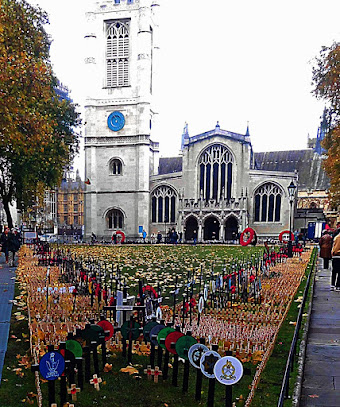WESTMINSTER
ABBEY IS costly for tourists to enter. Currently (November 2021) the entrance
ticket ranges in price from £10 for a child to £24 for a full-price adult
ticket. Without doubt, the Abbey is well worth a visit, but if you do not feel
like spending so much money, its neighbour, the St Margaret’s Church is also
full of interest but charges no entry fee.
Because
the present Abbey was once the church attached to a monastery, St Margaret’s
was built in the 11th and 12th centuries to provide a
place of worship for the (non-ecclesiastical) residents of Westminster. When
the residential population of the area declined, it became what it is now, the
parish church for The House of Commons. The first church on the site was built
in the Romanesque style, but when this deteriorated in the 14th
century, it was replaced by the present structure built in the Perpendicular
(gothic) style. Since then, like many old churches it has undergone various
modifications over the centuries.
Amongst
the many fascinating things within the church, which are described in an
excellent booklet by Tony Willoughby and James Wilkinson, several things
particularly attracted my attention. First of all, several of the windows in
the south wall of the church contain superb modern stained glass designed by
the painter John Piper (1903-1992) and created by Patrick Reyntiens (1925-2021).
The were installed in 1966 to replace Victorian windows that were destroyed
during WW2. Piper’s windows alone are a good reason to visit the church.
Another
thing that caught my eye is a pair of doors on the north side of the church.
These are covered with red leather, each one embossed in gold with a portcullis,
surmounted by a crown, the symbol of Parliament. Some of the prayer kneelers
are also decorated with this symbol.
Amongst
the many tombs and funerary memorials within the church, there is one to the
artist Wenceslaus Hollar (1607-1677). Born in Prague, he left the city when the
Emperor Ferdinand the Second ordered Bohemian nobility to convert to Roman
Catholicism or leave the country. A highly prolific and much-admired artist,
creator of many works including detailed views of London, he died a poor man in
Westminster. His monument is on the north wall.
Amongst
the many memorials on the south wall there is an oval plaque commemorating the
fact that in 1759, Olaudo Equiano (aka Gustavus Vassa) was baptised in the
church when he was a slave owned by a sea captain, Michael Henry Pascal. Equiano
(c1745-1797) was a black African slave, who gained (purchased) his freedom in 1766.
After numerous adventures, which he related in his autobiographical work “The
Interesting Narrative of the Life of Olaudah Equiano”, published in 1789 in
London, he became active in the nascent movement to abolish the slave trade. In
addition to his book, he wrote a great number of pamphlets and letters to the
press.
Whereas
I was able to spot the plaque for Equiano with no difficulty, I was unable to
see the grave of another abolitionist, also a former slave, Ignatius Sancho (c1729-1780),
who was born on a slave ship and is buried in the churchyard of St Margaret. He
married a West Indian woman, Anne Osborne, in St Margaret’s, ran a grocery shop
in Westminster, acted, composed music, and wrote against slavery using the
pseudonym “Africanus”. He was the first black Briton to vote in a parliamentary
election. He cast his vote both in 1774 and 1780.
In
addition to these two black abolitionists, the church contains memorials to two
men who tried to alleviate the suffering of slaves in the Americas, Richard
Burn (c1744-1822) and Thomas Southerne (1660-1746). The latter was one of the
first writers in English to denounce slavery.
I
hope that what I have written above will help to distract you from the idea of
visiting only Westminster Abbey and to encourage you to make plenty of time to
explore St Margaret’s.








No comments:
Post a Comment
Useful comments and suggestions are welcome!